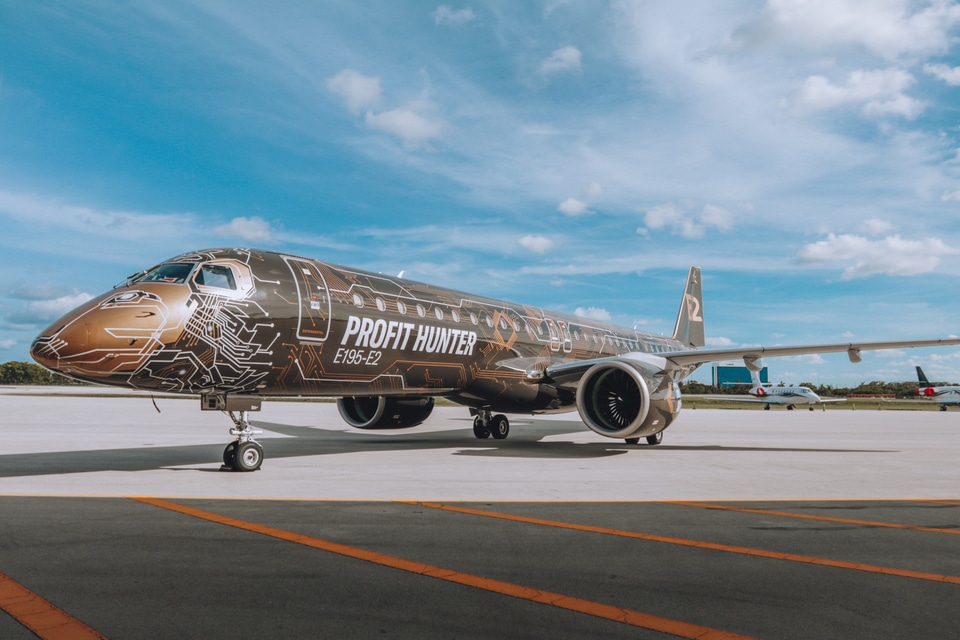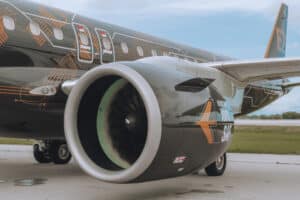Aviation
Embraer and Pratt & Whitney Complete 100% SAF Flight Testing of GTF-powered E195-E2 Aircraft

Fort Lauderdale, Fla., June 30, 2022 – Embraer and Pratt & Whitney have successfully tested a GTF-powered E195-E2 aircraft on 100% sustainable aviation fuel (SAF). The test, with one engine running on 100% SAF, validated that GTF engines and the E-Jets E2 family can fly on both engines with blends of up to 100% SAF without any compromise to safety or performance. The aircraft completed two days of ground tests at Fort Lauderdale International Airport, culminating in a 70-minute flight test at Vero Beach Regional Airport in Florida.
“The E2 is already the most efficient single-aisle aircraft flying today, saving up to 25% CO2 emissions compared to previous generation aircraft. This reduction in emissions can be increased up to an impressive 85% with 100% SAF. Replacement of older aircraft by new-generation products and scaling up SAF production are the two most effective actions commercial aviation can take now to achieve a significant reduction in emissions,” said Rodrigo Silva e Souza, vice president of strategy and sustainability, Embraer Commercial Aviation. “Embraer and Pratt & Whitney are leading the industry with products that are more efficient for our customers and more sustainable for our society. This test demonstrates that the E2 is ready for 100% SAF certification and operation once the industry finalizes standards.”
All Pratt & Whitney engines and Embraer aircraft are currently certified to operate with SAF blended up to 50% with standard Jet A/A1 kerosene, according to ASTM International specifications. Future specifications will enable blends of up to 100% SAF to maximize the emissions reduction potential of using fuel derived from sustainable, non-fossil-based feedstocks.
“SAF is a core part of our sustainability road map, and we continue to work with industry partners and regulators to support the development of a drop-in standard for 100% SAF,” said Graham Webb, chief sustainability officer at Pratt & Whitney. “This test proves that GTF engines can operate on any fuel, and that the E-Jets E2 family is ready for 100% SAF certification once the industry finalizes the standard for unblended SAF.”
The SAF used by Embraer and Pratt & Whitney was 100% Hydroprocessed Esters and Fatty Acids Synthetic Paraffinic Kerosine (HEFA-SPK) acquired from World Energy. HEFA-SPK is a specific type of hydrotreated renewable feedstock fuel used in aviation and is considered a leading alternative replacement for conventional jet fuel by the Commercial Aviation Alternative Fuels Initiative (CAAFI), due to the sustainability of its feedstock.
The Pratt & Whitney GTF™ engine is the only geared propulsion system delivering industry-leading sustainability benefits and world-class operating costs. The Embraer E195-E2 powered by GTF engines represents the most environmentally friendly combination of airframe and engine delivering the lowest level of noise and emissions.

Aviation
COMAC Unveils Plans for the C929 to Rival Airbus and Boeing

After the success of China’s first C919 aircraft, the country is setting its sights on developing a larger plane. COMAC (Commercial Aircraft Corporation of China) has officially confirmed plans to build a widebody aircraft, marking a significant step in its aircraft lineup.
Traditionally, Airbus and Boeing dominate the widebody aircraft market, with decades of expertise in developing planes and engines capable of carrying heavy payloads. China, which currently relies on imported engines, is now aiming to challenge these giants with its own widebody jet, the C929, designed to compete with the Airbus A350 and Boeing 777.
American Airlines Is Looking for Flight Attendants: Apply Now
The C929 will be China’s first independently developed long-range widebody aircraft. It adheres to international airworthiness standards and boasts independent intellectual property rights. The baseline version is designed to seat 280 passengers and offers a range of 12,000 kilometers, catering to global demand for both regional and international air travel.
Russia, which also needs reliable narrowbody and widebody aircraft, could become a key customer for the C929. Additionally, China plans to target the broader Asian market as it continues to expand its aviation capabilities.
Close Call at Heathrow: BA Flight Narrowly Escapes Drone Collision
China’s aviation progress includes the ARJ21 (now called C909), a regional jet with 100 seats for shorter routes, and the C919, a narrowbody jet with 180 seats designed to rival the Boeing 737 MAX and Airbus A320. Both models have found increasing demand in the domestic market.
At China’s largest air show in Zhuhai, COMAC announced that Air China will be the launch customer for the C929 widebody jet, though details about order size and delivery timelines were not disclosed.
Other major deals announced by COMAC include:
- Hainan Airlines: Firm orders for 60 C919 and 40 C909 regional jets.
- Colorful Guizhou Airlines: 30 C909 jets, with 20 firm orders and 10 provisional agreements.
The C929, renamed from the CR929 after Russia withdrew from the joint development project in 2023, is expected to carry 280–400 passengers with a range of 12,000 kilometers, competing directly with Boeing’s 787 Dreamliner.
According to COMAC’s deputy general manager, Tong Yu, the first fuselage section of the C929 is expected by September 2027, with prototype test flights anticipated soon after.
-

 Aviation2 months ago
Aviation2 months agoMicrosoft Flight Simulator Raises $3 Million to Bring Back the An-225 Mriya
-

 Airlines2 months ago
Airlines2 months agoQantas Engineers Stage Walkout Over Cost of Living Concerns
-

 Airlines2 months ago
Airlines2 months agoQatar Citizens Can Travel to the United States Without a Visa
-

 Aviation2 months ago
Aviation2 months agoQatar Airways bans these new Electronic Devices on plane
-

 Airlines2 months ago
Airlines2 months agoJapan Airlines Rolls Out Free Domestic Flights to International Passengers
-

 Defence2 months ago
Defence2 months agoWhich Country Has the Largest Fleet of Fighter Aircraft?
-

 Airport2 months ago
Airport2 months agoWestern Sydney Airport Welcomes Its First Plane After 6 Years of construction
-

 Aviation2 months ago
Aviation2 months agoDid you know ? Once Boeing 747 carried 1088 passenger in 1991









